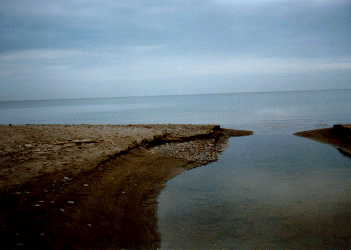FROM "THE SOUND" TO "THE LAKES"

As soon as British bans on American shipping were lifted after the Revolutionary War, Yankee traders began building large ships and sailing them profitably around the world. Connecticut had no deepwater harbor the size of Boston, Salem or New York but many a brig sailed from New London to South America, Nootka Sound, Hong Kong and Marseilles. Most cargoes clearing New London were headed for other U.S. ports along the Atlantic coast or for the West Indies trade.
Yankee mariners were never more than 10% of the population - but they transformed New England from a random collection of farming communities into a thriving regional economy and made it known throughout the world. Connecticut sailing folk bemoaned her geographical position - calling her a keg drained at both ends by Boston and New York - but by 1820, merchant traders and shipbuilders from the Nutmeg State had "captured" the port of New York, outnumbering native Yorkers employed in maritime trades and vastly outweighing New York in tonnage and shipbuilding.
Commerce generated cash - but the ups and downs of those turbulent times demanded a diversity of enterprises. Many Connecticut merchants were also early investors in frontier Vermont, Western New York, Muskingum and Marietta, Ohio. Especially attractive to those with maritime interests was the Ohio Western Reserve with its access to the Great Lakes. Because their homes had been burned by the British, many New Londoners received free land in the Firelands and pioneered the lake ports of Vermilion and Sandusky. Many others invested directly in Connecticut Land Company shares or joined with other Southeastern Connecticut investors in a subsidiary group called The Erie Company, which founded the capitol city of New Connecticut - Cleveland.
Although no systematic study has been done on the transfer of maritime culture from "The Sound" to "The Lakes," there is much anecdotal evidence that ties did exist. Samuel Livingston Mather, Jr. of Middletown, Connecticut; John Walworth of Groton; William Austin of New London went to the Western Reserve and had successful careers. Not all who started shipping enterprises prospered. In 1818, after a long and exciting career on the high seas, New London sea captain James Day "determined to quit the sea had twenty thousand dollars, went to the State of Ohio made some purchases built a schooner and began to lose money."
The War of 1812 provided an interesting connection. In May, 1813, the British blockaded the Thames River, trapping the American frigates United States and Macedonian and the sloop-of-war Hornet, which were brought up the river to Norwich until the end of the war. According to historian Frances Caulkins, the ships were partially dismantled and "the seamen were sent to the lakes, and were all so fortunate as to pass in boats, or other small craft, safely through the blockading fleet, and arrive at their destination." Some of them may have been in time to help complete the brig Lawrence, the Niagara, and the pilot boat Ariel at Erie, Pennsylvania. Under the direction of Pennsylvanian Dan Dobbins and Oliver Hazard Perry of Newport, Rhode Island, a fleet of six wooden ships was built of green timber from the nearby forest in eight months time and rolled on logs over the sandbar into the lake - to many historians a greater feat than Perry's famous victory on September 10.
Back East, a few ships did manage to run the British blockade. According to Caulkins, "the schooner O.H. Perry, 267 tons, built by Samuel Story (of Norwich) and just completed when the news came of Perry's victory on Lake Erie, dropped down to New London, and one night in November, passing by the blockading squadron, in nine hours reached New York in safety. But on her first voyage to St. Domingo the next spring, she was captured by the frigate Endymion."
The Battle of Lake Erie had turned the tide against the British and their Indian allies on the western front. But there was little enthusiasm in New England for this war, which together with the embargo that preceded it, had virtually destroyed all commerce. New London and other coastal cities remained depressed and in her History of Norwich, Caulkins recalls:
The 4th of July, 1814, brought with it but little festivity. A pleasant incident, however, occurred at Norwich. The Thames Hotel was at this time rented by Capt. Christopher R. Perry, the father of Commodore Perry. On the day of Jubilee, a party of gentlemen from the city had a public diinner at the hotel and just before sitting down to the table, the heroic Commodore himself unexpectedly arrived from the lakes on a visit to his father. Great was the cheering, and the joyous acclamations reached the dismantled squadron below, where the few officers in charge were dining on the deck of the Macedonian and the river was enlivened with a succession of responsive cheers and salutes.
RECENT RESEARCH
Considerable scholarly interest has been focused during the last several years on early maritime commerce and on using U.S. Naval records and other sources to document the origins of individual sailors. Other research in black history has centered specifically on black sailors, shipwrights and sea captains of early New England.
